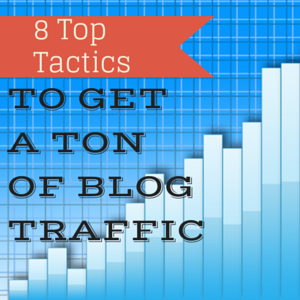
Blogging is along, drawn out marathon. Some people question themselves right when the starting gun goes off. Others question themselves on the last mile. While in a marathon you know the finish line’s location, the location of the finish line for blogging (for this analogy, the finish line represents a blogging empire) is unknown. You won’t know where that finish line is until you step on it.
During the journey to a blogging empire, you will encounter some bumps along the way. You may quickly get over some bumps and question yourself on some of the other bumps. When you lose faith in your blog, you need two things:
- Inspiration
- Clarity
The inspiration is easy to get. Just read some case studies about blogs that suddenly started growing like crazy. This picture is the most inspirational picture I saw throughout my journey.
The only problem with inspiration is that inspiration alone is only a temporary solution. You feel inspired in the moment, but are you ready for the next bump? To be ready for the next bump, you must build upon your clarity.
For your blogging strategy, building your clarity means devising a step by step plan. What are you going to do today to get more blog traffic? What are you going to do tomorrow? What are you going to do throughout the month?
Every week, I take some time to look at my plan and identify different methods I could utilize to get more blog traffic. I now invest in Facebook advertising because it’s having an impact on my blog’s traffic. Spending an hour going through my tweets and analyzing the results for each of those tweets lets me know what I should continue tweeting and what I should stop tweeting.
How did I reach the conclusion of focusing on Twitter and Facebook? The answer is that Twitter is my blog’s main source of traffic, and Facebook has some on and off days. Putting more time towards Facebook now allows me to see more “on days” than “off days.”
Look at what you are doing for your blog right now. See where you are getting your best and worst results. Focus on amplifying the platforms you use to get your best results, and don’t spend as much time on the platforms that yield poor results.
Combine that with some research to discover more ways to get traffic and sales, and you’ll have a strong plan.
At this point, inspiration and clarity are both working for you. These two ingredients are enough to get you through a few days feeling the blogger’s high. However, there is one more piece to the puzzle. Let me give you a hint:
Any plan that looks good is just theoretically good.
You can’t say a plan is good until it brings in the results. A plan to bring in money isn’t the same as actually bringing in money. Implementing the plan lets you see how good that plan actually is.
I created a plan for profiting from Facebook ads and growing my audience with Page like ads. For an entire week, I was anxious about the plan. Even though I knew the plan was good, I had no idea what would happen. Plans are theoretical, not reality. However, plans let you tackle reality more effectively.
After you create your step by step action plan, act upon it. Don’t wait for next week to get started. Get started now. If you get started now and keep at it every day, it doesn’t take long for a plan to turn into a habit. An effective plan that gets implemented habitually spells out success.
So how do you go about implementing your own plan? The answer is to start small and build your way up. If you consider Facebook ads for your business, it doesn’t take long to understand how confusing it could get. There are more than a dozen different ads you can create and advanced audience targeting tools.
So I decided to only create a Facebook ad for getting more Page Likes. I knew that to make a profit on Facebook, I would need more than that one ad, but I needed to get started. Focusing on that ad for a few days allowed me to learn a lot about Facebook advertising. I quickly got the cost down to $0.01 per like and got over 10,000 likes in my first month. I aspire to surpass 100,000 Facebook likes by the end of the year.
Only after I understood the Facebook Page Like ad did I start utilizing other Facebook ads. You can’t have a blogging plan that takes you from zero visitors to 100,000 visitors in one year. However, you can have a plan for getting 1,000 visitors in your first month. You can create a plan that allows you to scale your growth month by month so you eventually get 100,00 visitors in one year.
In Conclusion
The blogging journey has its triumphs and bumps along the way. It is how you get through the bumps that determines how likely you are to become successful. Starting with accomplishing a small goal gives you the small win. Putting a string of small wins together results in long-term success.
Successful blogging requires inspiration, clarity, and taking action. Until a plan gets implemented, that plan is theoretical. No matter how good a plan seems on paper, the power of that plan is determined by the implementation.
How do you stay strong through challenging times with your blog? Which of these tips was your favorite? Sound off in the comments section below.




